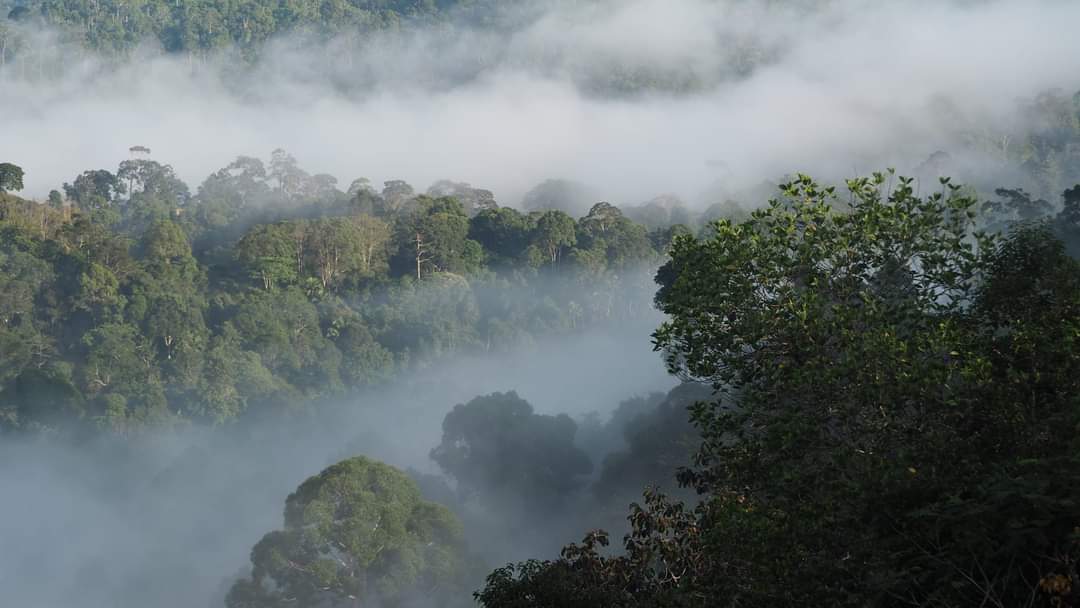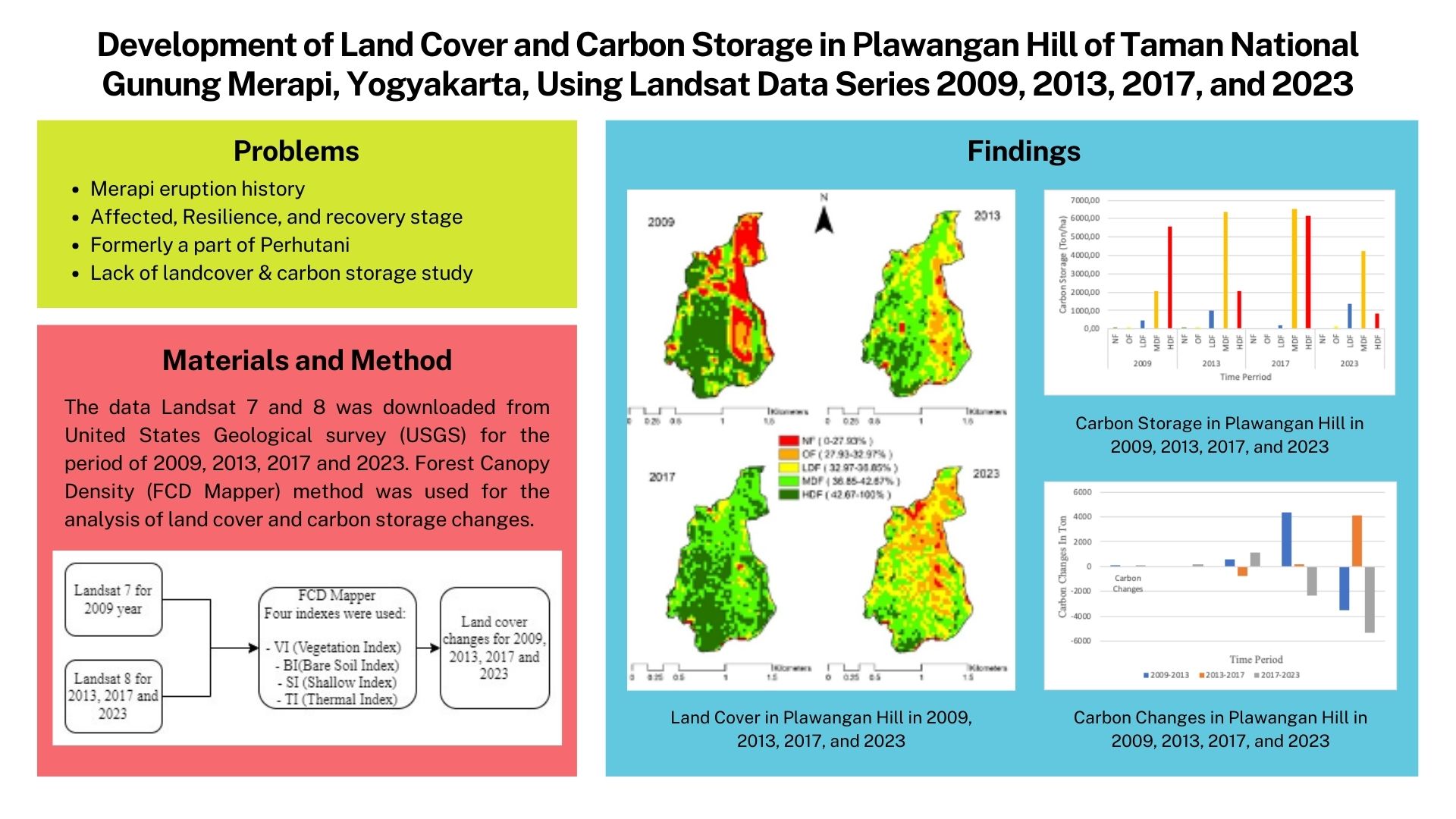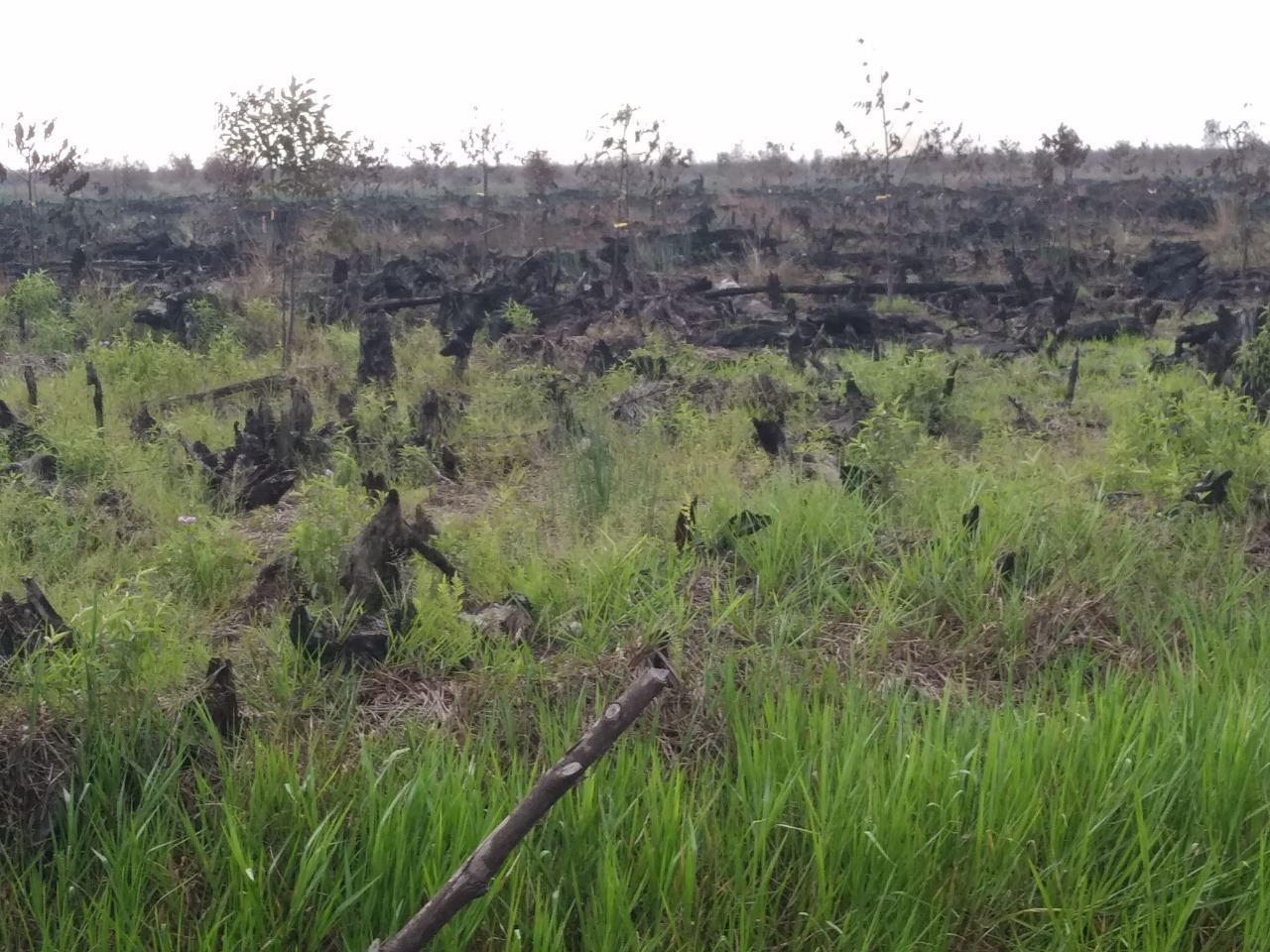Environment Degradation and Rural Livelihood of Mulawarman Community in Indonesia
Abstract
This article aims to describe the livelihoods of communities around the mining area through cases in Mulawarman Village, Tenggarong Seberang District, Kutai Kartanegara Regency, East Kalimantan Province, Indonesia. This research uses a qualitative method with a case study approach. These findings show that the vegetation index value in Mulawarman Village degraded from 2014 (0.35) until 2019 (0.33). It shows forest degradation, which affects the livelihoods of rural communities that depend on agriculture or forestry. The leading cause of the decline in the vegetation index value is the expansion of coal mining activities. Indirectly, coal mining activities have limited the ability of the Mulawarman village community to access natural resources. Some residents of Mulawarman village have decided to sell agricultural land and move to other places. However, residents still survive to live in Mulawarman village by starting livestock and trading businesses to maintain their livelihoods.
References
Agustiawan, H. (2014). Implementasi izin usaha pertambangan mineral bukan logam. Jurnal Kebijakan Publik, 5(1), 111–114. https://doi.org/10.31258/jkp.v5i3.2235
Albore, A. (2018). Review on determinants of sustainable rural livelihood diversification of small holder farmers in Ethiopia. International Journal of Advanced Research, 6(2), 251–259. https://doi.org/10.21474/ijar01/6436
Amin, C., Sukamdi, & Rijanta, R. (2019). Livelihood changes of fisherman community driven by climate change: A case study in Semarang coastal region, Central Java, Indonesia. Humanities and Social Sciences Reviews, 7(3), 267–273. https://doi.org/10.18510/hssr.2019.7341
Amrifo, V. (2013). Analisis sosiologis ekonomi kelembagaan dalam transformasi sosio kultural masyarakat adat (Kasus Suku Duano di Provinsi Riau). Jurnal Terubuk, 41(1), 62–74.
Amrifo, V., Dharmawan, A. H., Sunito, S., & Soetarto, E. (2014). Sejarah sosiologis budaya bernafkah komunitas adat Suku Duano. Paramita: Historical Studies Journal, 24(2), 186–199. https://doi.org/10.15294/paramita.v24i2.3122
Andini, S. W., Prasetyo, Y., & Sukmono, A. (2018). Analisis sebaran vegetasi dengan citra satelit Sentinel menggunakan metode NDVI dan segmentasi (Studi kasus: Kabupaten Demak). Jurnal Geodesi Undip, 7(1), 14–24.
Ariani, D., Prasetyo, Y., & Sasmito, B. (2020). Estimasi tingkat produktivitas padi berdasarkan algoritma NDVI, EVI dan SAVI menggunakan citra Sentinel-2 multitemporal (Studi kasus: Kabupaten Pekalongan, Jawa Tengah). Jurnal Geodesi Undip, 9(1), 325–334.
Arsyiah, W. O. (2018). Implementasi kebijakan pengelolaan tambang galian C di Kecamatan Batauga Kabupaten Buton Selatan. Public Inspiration: Jurnal Administrasi Publik, 3(1), 26–33. https://doi.org/10.29210/3003755000
Badri, S. A., Asgary, A., Eftekhari, A. R., & Levy, J. (2006). Post-disaster resettlement, development and change: A case study of the 1990 Manjil earthquake in Iran. Disasters, 30(4), 451–468. https://doi.org/10.1111/j.0361-3666.2006.00332.x
Baffoe, G. (2017). Moving beyond the sustainable livelihood rhetoric: A conceptual model of rural livelihood sustainability. Developing Country Studies, 7(9), 37–47.
Baon, J. B., Prawoto, A. A., Wibawa, A., & Abdoellah, S. (2014). Increasing cocoa productivity and farmer capacity in surrounding area of PT Kaltim Prima Coal and PT Berau Coal. Journal of Degraded and Mining Lands Management, 1(2), 97–104. https://doi.org/10.15243/jdmlm.2014.012.097
Barkatullah, A. H., & Ifrani. (2018). Penyeimbangan terhadap dampak negatif kebijakan pertambangan batu bara. Bina Hukum Lingkungan, 3(1), 34–48. https://doi.org/10.24970/jbhl.v3n1.3
Brown, D. R., Stephens, E. c, Ouma, J. O., Murithi, F. M., & Barrett, C. B. (2006). Livelihood strategies in the rural Kenyan highlands. African Journal of Agricultural and Resource Economics, 1(1), 21–36. https://doi.org/10.22004/ag.econ.57019
Chambers, R., & Conway, G. R. (1992). Sustainable rural livelihoods: Practical concepts for the 21st century. IDS Discussion Paper 296. Brighton: Institute of Development Studies. Retrieved from https://opendocs.ids.ac.uk/opendocs/handle/20.500.12413/775
Devy, D. S., & Sarungallo, C. (2018). Groundwater aquifer study on coal mining area: A case of North Samarinda, Indonesia. Journal of Degraded and Mining Lands Management, 6(1), 1483–1493. https://doi.org/10.15243/jdmlm.2018.061.1483
Ding, W., Jimoh, S. O., Hou, Y., Hou, X., & Zhang, W. (2018). Influence of livelihood capitals on livelihood strategies of herdsmen in inner Mongolia, China. Sustainability, 10(9), 3325. https://doi.org/10.3390/su10093325
Dye, T. (2014). Top-down policymaking. Washington DC: CQ Press. https://doi.org/10.4135/9781483330150
Erlyani, N. (2013). Social prejudice of people in mining area. Ecopsy, 1(1), 33–37. https://doi.org/10.20527/ecopsy.v1i1.483
Ernawati, J., Resources, E., & Master, M. (2013). Fisherman’s participation in assessing level of sustainable livelihood in Surabaya Coastal City, Indonesia. Research on Humanities and Social Sciences, 3(10), 51–57.
Fitryarini, I. (2018). Participatory communication and sustainability development: Case study of coal mining environment in East Kalimantan, Indonesia. International Journal of Multicultural and Multireligious Understanding, 5(3), 133139. https://doi.org/10.18415/ijmmu.v5i3.275
Fünfgeld, A. (2016). The state of coal mining in East Kalimantan: Towards a political ecology of local conditions. Austrian Journal of South-East Asian Studies, 9(1), 147–162. https://doi.org/10.14764/10.ASEAS-2016.1-9
Gandi, R., Sunito, S., & Kinseng, R. A. (2015). Industrialisasi pertambangan dan deagrarianisasi masyarakat desa. Sodality: Jurnal Sosiologi Pedesaan, 3(1), 50–62. https://doi.org/10.22500/sodality.v3i1.9431
Gibson, J., & Olivia, S. (2010). The effect of infrastructure access and quality on non-farm employment and income in rural Indonesia. World Development, 38(5), 717–726. https://doi.org/10.1016/j.worlddev.2009.11.010
Gunawan, B. I. (2016). The diversity of fisheries based livelihoods in the Berau Delta, East Kalimantan. Wacana, 17(1), 68–96. https://doi.org/10.17510/wacana.v17i1.429
Hasyim, W. (2013). Building resilience of livelihood systems to disaster: Lessons learned from the tsunami disaster recovery process. Proceedings of AICS-Social Sciences, 313–322. Retrieved from http://www.jurnal.unsyiah.ac.id/AICS-Social/article/view/6544
Hidalgo, H. A., & Cuesta, M. (2018). Remodelling livelihood vulnerability indicators for the informal food microentrepreneurs. SEAS (Sustainable Environment Agricultural Science), 2(1), 1–9. https://doi.org/10.22225/seas.2.1.672.1-9
Huang, L., Yang, L., Tuyến, N. T., Colmekcioglu, N., & Liu, J. (2022). Factors influencing the livelihood strategy choices of rural households in tourist destinations. Journal of Sustainable Tourism, 30(4), 875–896. https://doi.org/10.1080/09669582.2021.1903015
Israr, M., Khan, H., Jan, D., & Ahmad, N. (2014). Livelihood diversification: A strategy for rural income enhancement. Journal of Finance and Economics, 2(5), 194–198. https://doi.org/10.12691/jfe-2-5-10
Juhaidi, A. (2012). Program CSR pendidikan perusahaan pertambangan batu bara. Jurnal Administrasi Pendidikan, 14(1), 104–119. https://doi.org/10.17509/jap.v14i1.6712
Kabir, M. S., Hou, X., Akther, R., Wang, J., & Wang, L. (2012). Impact of small entrepreneurship on sustainable livelihood assets of rural poor women in Bangladesh. International Journal of Economics and Finance, 4(3), 265280. https://doi.org/10.5539/ijef.v4n3p265
Kasim, Y., Ibrahim, A. Z., & Badariah, B. H. D. (2017). The viability of livelihood assets, livelihood strategy and government intervention towards ensuring sustainable poverty reduction: A pilot test. Asian Journal of Multidisciplinary Studies, 5(7), 103–111.
Khatiwada, S. P., Deng, W., Paudel, B., Khatiwada, J. R., Zhang, J., & Su, Y. (2017). Household livelihood strategies and implications for poverty reduction in rural areas of central Nepal. Sustainability, 9(4), 612. https://doi.org/10.3390/su9040612
Kibwage, J. K., Odondo, A. J., & Momanyi, G. M. (2009). Assessment of livelihood assets and strategies among tobacco and non-tobacco-growing households in Kenya's south Nyanza region. African Journal of Agricultural Research, 4(4), 294–304.
Listiyani, N. (2017). Dampak pertambangan terhadap lingkungan hidup di Kalimantan Selatan dan implikasinya bagi hak-hak warga negara. Al'Adl: Jurnal Hukum, 9(1), 67–86. https://doi.org/10.31602/al-adl.v9i1.803
Liu, Z., Chen, Q., & Xie, H. (2018). Influence of the farmer’s livelihood assets on livelihood strategies in the western mountainous area, China. Sustainability, 10(3), 875. https://doi.org/10.3390/su10030875
Liyama, M., Kariuki, P., Kristjanson, P., Kaitibie, S., & Maitima, J. (2008). Livelihood diversification strategies, incomes and soil management strategies: A case study from Kerio Valley, Kenya. Journal of International Development, 20(1), 380–397. https://doi.org/10.1002/jid
Mekonen, K. D. (2016). Women’s livelihood in the informal sector: Analysis of micro sellers or “gullit” in Addis Ababa City, Ethiopia. Developing Country Studies, 6(8), 80–88.
Muriadi, & Wijaya, A. F. (2013). A method for assessing household vulnerability to flood at regency level in Indonesia. J-PAL (Journal of Sustainable Development), 4(2), 39–44.
Mutahara, M., Haque, A., Khan, M. S. A., Warner, J. F., & Webster, P. (2016). Development of a sustainable livelihood security model for storm-surge hazards in the coastal areas of Bangladesh. Stochastic Environmental Research and Risk Assessment, 30(5), 1301–1315. https://doi.org/10.1007/s00477-016-1232-8
Natalia, I. V. (2019). Law enforcement towards environmental damage and pollution caused by open-pit coal. Tarumanegara Law Review, 1(1), 62–90. https://doi.org/10.1088/1755-1315/519/1/012023
Nayak, P. K. (2017). Fisher communities in transition: understanding change from a livelihood perspective in Chilika Lagoon, India. Maritime Studies, 16, 13 (2017). https://doi.org/10.1186/s40152-017-0067-3
Ndhlovu, E. (2018). Relevance of sustainable livelihood approach in Zimbabwe’s land reform programme. Africa Insight, 47(4), 72–88.
Pandey, R. (2017). Life and livelihoods in the ‘Forbidden Kingdom’, the Trans-Himalaya, Nepal. Dhaulagiri Journal of Sociology and Anthropology, 11, 24–59. https://doi.org/10.3126/dsaj.v11i0.18822
Parmawati, R., Saktiawan, Y., Wibowo, F. A. A., & Kurnianto, A. S. (2018). Analysis of village tourism development in Sawahan, Trenggalek Regency, Indonesia: A sustainable livelihood approach. E-Journal of Tourism, 5(1), 4653. https://doi.org/10.24922/eot.v5i1.35181
Pasaribu, L. R. (2007). Gambaran kondisi pertambangan batu bara pada kejadian status gizi ibu hamil di Provinsi Kalimantan Selatan (Analisis lanjut RISKESDAS 2007). Jurnal Kesehatan Reproduksi, 5(3), 135–143. https://doi.org/10.22435/kespro.v5i3.3891.135-143
Peng, W., Robinson, B. E., Zheng, H., Li, C., Wang, F., & Li, R. (2019). Telecoupled sustainable livelihoods in an Era of rural-urban dynamics: The case of China. Sustainability, 11(9), 2716. https://doi.org/10.3390/su11092716
Rahmatullah, Ahmed, I., Shah, S. A., Rasheed, M., Ali, N., & Kayani, A. S. (2015). Impact of climate change on livestock composition in Pothwar Region, Pakistan. Science, Technology and Development, 34(4), 270–273. https://doi.org/10.3923/std.2015.270.273
Rani, M. (2016). Insurance protection for fisherman. Jurnal Selat, 4(1), 1–14.
Resosudarmo, B. P., Sugiyanto, C., & Kuncoro, A. (2013). Livelihood recovery after naturaldisasters and the role of aid: The case of the 2006 Yogyakarta earthquake. Journal of Chemical Information and Modeling, 53(9), 1689–1699.
Roby, Yuanita, & Mentari, S. D. (2018). Pengembangan tanaman kenaf (Hibiscus cannabinus L) pada lahan pasca tambang batu bara. Soilerns, 16(1), 9–13. https://doi.org/https://doi.org/10.24198/soilrens.v16i1.18308
Sabania, H., & Hartoyo, H. (2016). Economic pressure, livelihood strategy, and family well-being in Cimanuk Watershed, Garut and Indramayu, West Java, Indonesia. Journal of Family Sciences, 1(1), 24–38. https://doi.org/10.29244/jfs.1.1.24-38
Santoso, A. D., & Setiawan, A. (2009). Mengapa pH kolom bekas tambang relatif stabil ? Hidrosfir Indonesia, 4(1), 9–15.
Sarminah, S., Kristianto, D., & Syafrudin, M. (2018). Analisis tingkat bahaya erosi pada kawasan reklamasi tambang batu bara PT Jembayan Muarabara Kalimantan Timur. ULIN: Jurnal Hutan Tropis, 1(2), 154–162. https://doi.org/10.32522/u-jht.v1i2.793
Siburian, R. (2020). Formasi sosial di Desa Kerta Buana: Transformasi dari masyarakat pertanian menjadi masyarakat pertambangan. Jurnal Masyarakat dan Budaya, 22(3), 49–62. https://doi.org/10.14203/jmb.v22i3.1024
Su, F., Saikia, U., & Hay, I. (2018a). Relationships between livelihood risks and livelihood capitals: A case study in Shiyang River Basin, China. Sustainability, 10(2), 509. https://doi.org/10.3390/su10020509
Su, M., Sun, Y., Min, Q., & Jiao, W. (2018b). A Community livelihood approach to agricultural heritage system conservation and tourism development: Xuanhua Grape Garden Urban Agricultural Heritage Site, Hebei Province of China. Sustainability, 10(2), 361. https://doi.org/10.3390/su10020361
Subarudi, Kartodihardjo, H., Soedomo, S., & Sapardi, H. (2016). Conflict resolution policy on coal mining businesses in forest areas in East Kalimantan. Jurnal Analisis Kebijakan, 13(1), 53–71. https://doi.org/10.20886/jakk.2016.13.1.53-71
Sudarsono, N. W., Sudarsono, B., & Wijaya, A. P. (2016). Analisis fase tumbuh padi menggunakan algoritma NDVI, EVI, SAVI, dan LSWI pada citra Landsat 8. Jurnal Geodesi Undip, 5(1), 125–134.
Suharto, R. B., Hilmawan, R., & Yudaruddin, R. (2015). Sumber daya alam untuk kesejahteraan penduduk lokal: Studi analisis dampak pertambangan batu bara di empat kecamatan area Kalimantan Timur, Indonesia. Jurnal Organisasi dan Manajemen, 11(2), 127–137. https://doi.org/10.33830/jom.v11i2.178.2015
Sukariamat. (2013). Implementasi Peraturan Menteri Energi dan Sumberdaya Mineral No. 28 Tahun 2009 tentang penyelenggaraan usaha jasa pertambangan mineral dan batu bara. Jurnal Administrasi Reform, 1(2), 462–473. https://doi.org/10.52239/jar.v1i2
Suoth, A., & Nazir, E. (2014). Penaatan perusahaan tambang batu bara di Kalimantan Timur terhadap peraturan air limbah pertambangan. Ecolab, 8(2), 61–68. https://doi.org/10.20886/jklh.2014.8.2.61-68
Swathilekshmi, P. S. (2010). Factors influencing the livelihood index and level of aspiration of fisherwomen. Journal of the Indian Fisheries Association, 35(1), 75–85.
Venu, B. N., Umesh, K. B., & Gujanana, T. M. (2018). Livelihood security of agricultural labour households in rainfed region of north-Karnataka-An economic analysis. Indian Journal of Agricultural Research, 52(5), 463–471. https://doi.org/10.18805/IJARe.A-4707
Walelign, S. Z., Pouliot, M., Larsen, H. O., & Smith-Hall, C. (2017). Combining household income and asset data to identify livelihood strategies and their dynamics. Journal of Development Studies, 53(6), 769–787. https://doi.org/10.1080/00220388.2016.1199856
Wang, X., Peng, L., Xu, D., & Wang, X. (2019). Sensitivity of rural households’ livelihood strategies to livelihood capital in poor mountainous areas: An empirical analysis in the upper reaches of the Min River, China. Sustainability, 11(8), 2193. https://doi.org/10.3390/su11082193
Yuerlita, Perret, S. R., & Shivakoti, G. P. (2013). Fishing farmers or farming fishers? Fishing typology of inland small-scale fishing households and fisheries management in Singkarak Lake, West Sumatra, Indonesia. Environmental Management, 52(1), 85–98. https://doi.org/10.1007/s00267-013-0050-8
Yunianto, B. (2009). Analysis of small-scale mining in mineral and coal mining law number 4/2009 (inputs for formulation of implementing regulation). Indonesian Mining Journal, 12(3), 97–104. https://doi.org/10.30556/imj.Vol12.No3.2009.551
Zada, M., Shah, S. J., Yukun, C., Rauf, T., Khan, N., & Shah, S. A. A. (2019). Impact of small-to-medium size forest enterprises on rural livelihood: Evidence from Khyber-Pakhtunkhwa, Pakistan. Sustainability, 11(10), 2989. https://doi.org/10.3390/su11102989
Zaini, A. (2018). Pengaruh kekayaan sumberdaya alam batu bara terhadap ketimpangan pendapatan di Provinsi Kalimantan Timur. Jurnal Borneo Administrator, 13(2), 111–130. https://doi.org/10.24258/jba.v13i2.309
Zubayr, M., Darusman, D., Nugroho, B., & Ridho Nurrochmat, D. (2014). Peranan para pihak dalam implementasi kebijakan penggunaan kawasan hutan untuk pertambangan. Jurnal Analisis Kebijakan Kehutanan, 11(3), 239–259. https://doi.org/10.20886/jakk.2014.11.3.239-259
Authors

This work is licensed under a Creative Commons Attribution 4.0 International License.
Jurnal Manajemen Hutan Tropika is an open access journal which means that all contents is freely available without charge to the user or his/her institution. Users are allowed to read, download, copy, distribute, print, search, or link to the full texts of the articles in this journal without asking prior permission from the publisher or the author. This is in accordance with the Budapest Open Access Initiative (BOAI) definition of open access.








